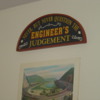Simple question but haven't been able to find on forum search or in book. To Make a D.C.S. star wiring block, does one cut the outside rails along with the central rail ? I have T.I.U. Rev L. and use 180 Bricks for each channel. Having problems losing engine ident. even with good signal (10 -7). I have not defined blocks with cutting outside rails. Would this be my problem ?
Replies sorted oldest to newest
Center rail only needs isolation. Losing engine Id's sounds more like a battery problem and not wiring. I have the same set up as you, Rev L with PH-180's, isolation blocks are center rail only and I have no problems. My outside rails are continuous, no breaks. Only one outside rail is connected to the TIU.
Thanks for your input. I do have both outside rails mostly tied together if for no other reason that if one with gargraves track to have the non derailer to work with ross switches, both outside rails need to be tied together for it to work in both directions. By the theory of digital signals being equal distance to travel to T.I.U., as discussed in Barry's book, cutting outside rail would make accomplish that. It would be like each block was a test track> But if you are not having any problem, can't dis-agree with good results.
Don't cut the outside rails. It will not affect your DCS signal either way.
Thanks! I' am sorry I couldn't understand that point from your book. It's really great that you monitor this forum. Thanks again.
If you are using Gargraves, it is very important to connect the outside rails to each other.
Asheville,
As you build your blocks use the 12 track discipline for each block you build. It's the joins you are trying to eliminate, if you have some long straight aways, use the large 36" tracks. The less joins you have the better, the signal travels. I also use the magic lights where needed, and at the head of the terminal blocks. Do not cut the outside rail.
PCRR/Dave
Thanks for info. You are saying that every 12 joins, make a new block with drop wire back to terminal strip. drop wire should have both ground and hot leads.
Asheville,
Roger that and test as you build, use the magic lights where needed. I used street lights and under slung trestle lights, along with magic lights in front of each terminal block, & lighted lock on's, to achieve all 10's thru out my larger multi level layout. Now with the newer TIU's the use of magic lights has been reduced to a minimal requirement.
PCRR/Dave
Attachments
A common error is to run only one wire from transformer or TIU to outside rails. Remember that, for power distribution purposes, voltage drop in outside rails approximates that of the center rail. So frequent ground feeds to outside rails are essential to assure adequate power. While it is not necessary to have one for each block, frequent ground drops are important.
I don't know about the 12-track "rule." Since my rather large layout was built before DCS, and intended for multi-train conventional operation, it is divided into many rather short blocks, each with its own toggle switch on the control panel, and a heavy copper buss around the layout for ground. But I do know from experience that voltage drop on the tracks is a concern.
Given that we're talking about a transmission line here, I would think keeping the grounds and center lead paired would be the best option.
Guns,
Absolutely correct, when run in pairs at the same length everything works quite well, for DCS. Now Legacy is a different matter.
RJR,
The 12 track (Join) rule for each block works out real well, however once you go over 13 joins the signal starts to vary (drop), I tested this rule more than one time, every time I had more than 12 joins, I would need to drop a magic light to help the signal stay up around 10. In reality it is not track footage that matters, it the track joins that alter the signal the most. For some reason even with the good FasTrack flat pin joins, the signal was altered, and so I started using the long 36" FT sections on my big straight aways, doing this kept my signal at all 10's. You can cheat here and there depending on how close you are to the TIU, but the 12 track join rule holds pretty darn accurate, as a DCS building technique.
PCRR/Dave
I kid GRJ about his closet looking like Fibber McGee's, but I'm no better. I try never to throw anything away. Somewhere I have a device I made up several decades ago, consisting of a 1 or 2 ohm high-wattage resistor with alligator clips. I would connect it across the tracks at the ends of blocks, and apply power to the track. I would measure the voltage at the transformer and at the end of each block. The difference is amazing. I could use a voltmeter (connected to the same wire some distance apart) to ascertain where voltage drop was occurring, and cure the drop as best I could. This is what caused me to go to 14-gauge wire for track feeds, but I could do nothing about track joints. FYI, a real bummer was UCS tracks, and for some I installed jumpers from one end to the other.
In a buried portion of the layout, for storage, I had used Lionel tubular track, of which I have much in boxes, as an economy move, but ran a jumper wire solder to the center rail of each track. Some of this track is over 70 years old, and loose pins and hidden rust is a consideration. Pins can loosen during operation, as the track flexes minutely.
OGR wire is perfect for DCS wiring, comes already paired up.






